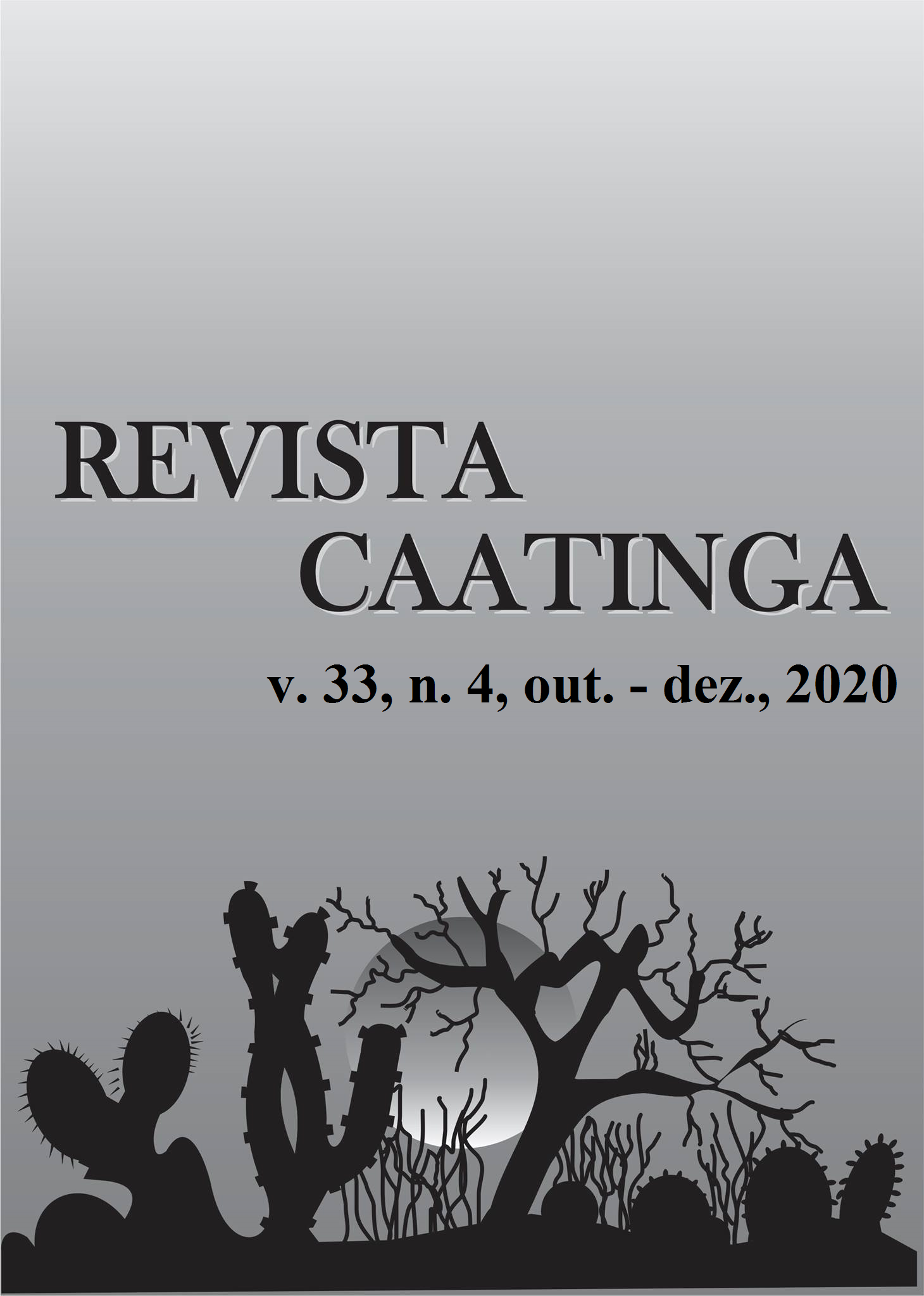MORPHOLOGICAL CHARACTERIZATION AND GENETIC DIVERSITY IN ORNAMENTAL SPECIMENS OF THE GENUS SANSEVIERIA
DOI:
https://doi.org/10.1590/1983-21252020v33n413rcKeywords:
Germplasm collection. Genetic diversity. Ornamental plants.Abstract
The aim of this study was to characterize and estimate genetic divergence among twelve specimens of the Sansevieria genus from the collection of the Universidade Federal do Piauí (UFPI). A completely randomized experimental design was used with three replicates, and the plot consisted of four plants. In morphological characterization, qualitative and quantitative descriptors of leaves were evaluated. Genetic divergence among the specimens was determined by the Tocher clustering method and the hierarchical UPGMA. There is genetic variation among specimens evaluated, which was also expressed by the variability of colors, shapes, and sizes of the leaves. The Tocher clustering method and the hierarchical UPGMA were effective in differentiation of the specimens from multi-categorical qualitative descriptors, as the Tocher method grouped the accessions in two groups and the UPGMA in seven different groups. We highlight the accessions SSV 09 and SSV 10 as exhibiting the highest mean values in weekly leaf growth and in leaf height, important characteristics for local sale and for export.
Downloads
References
BALDWIN, A. S.; WEBB, R. H. The genus Sansevieria: An introduction to molecular (DNA) analysis and preliminary insights to intrageneric relationships. Sansevieria, 34: 14-26, 2016.
BIONDI, D.; LEAL, L. Caracterização das plantas produzidas no Horto Municipal da Barreirinha-Curitiba/PR. Revista da Sociedade Brasileira de Arborização Urbana, 3: 20-36, 2019.
CANTELLI, D. A. V. et al. Analysis of the genetic divergence of soybean lines through hierarchical and Tocher optimization methods. Genetics and Molecular Research, 15: 1-13, 2016.
CARNEIRO, J. L. S. Caracterização acessos de sisal usando descritores da planta e da fibra. 2016. 117 f. Tese (Doutorado em Agronomia: Área de Concentração em Recursos Genéticos Vegetais) Universidade Estadual de Feira de Santana, UEFS, Feira de Santana, 2017.
COSTA, L. V. et al. Caracterização morfológica de acessos de pimentas do Amazonas. Horticultura Brasileira, 33: 290-298, 2015.
COSTA, M. F. et al. Characterization and Genetic Divergence of Casearia grandiflora Populations in the Cerrado of Piaui State, Brazil. Floresta e Ambiente, 23: 387-396, 2016.
CRUZ, C. D.; REGAZZI, A. J.; CARNEIRO, P. C. S. Modelos biométricos aplicados ao melhoramento genético. 4.ed. Viçosa, MG: UFV, 2013. 514 p.
CRUZ, C. D. Genes Software-extended and integrated with the R, Matlab and Selegen. Acta Scientiarum Agronomy, 38: 547- 552, 2016.
FIGÁS, M. R. et al. Variation of morphological descriptors for the evaluation of tomato germplasm and their stability across different growing conditions. Scientia Horticulturae, 238: 107-115, 2018.
FRANCK, A. R. Guide to agave, cinnamomum, corymbia, eucalyptus, pandanus, and sansevieria in the flora of Florida. 2012. Disponível em: <https://scholarcommons.usf.edu/bcm_facpub/6/>. Acesso em: 10 jul. de 2020.
GARBEZ, M. et al. Ornamental plants architectural characteristics in relation to visual sensory attributes: a new approach on the rose bush for objective evaluation of the visual quality. European Journal of Horticultural Science, 83: 87-201, 2017.
GILMAN, E. F. Sansevieria trifasciata Hahnii. Cooperative Extension Service. 1 ed. University of Florida, USA: Fact Sheet FPS, 1999. 534 p.
JUNQUEIRA, A. H; PEETZ, M. S. O setor produtivo de flores e plantas ornamentais do Brasil, no período de 2008 a 2013: atualizações, balanços e perspectivas. Revista Brasileira de Horticultura Ornamental, 20: 115-120, 2014.
MELO, C. A. F. et al. Morphological characterization and genetic parameter estimation in backcrossed progenies of Passiflora L. for ornamental use. Scientia Horticulturae, 212: 91-103, 2016.
MENEGATTI, R. D. et al. Genetic divergence among provenances of Mimosa scabrella Benth. based on seed analysis. Revista Brasileira de Ciências Agrárias, 12: 366-371, 2017.
MITROFANOVA, I. V.; ZAKUBANSKIY, A. V.; MITROFANOVA, O. V. Viruses infecting main ornamental plants: an overview. Ornamental Horticulture, 24: 95-102, 2018.
NASCIMENTO, T. M; GRAZIANO, T. T.; LOPES, C. S. Espécies e cultivares de sansevierias como planta ornamental. Revista Brasileira de Horticultura Ornamental, 9: 111-119, 2003.
NEWTON, L. E. Conservation of Sansevierias in Kenya. 2018. Disponível em: < https://www.sansevieria.lima-city.de/gb/so2018_1_12-18.pdf>. Acesso em: 15 out. 2018.
OLIVEIRA, C. D. C. et al. Riqueza de mudas de espécies florestais nativas potencialmente produzidas na Bacia do Rio Grande, MG. Pesquisa Florestal Brasileira, 37: 159-170, 2017.
PÉREZ-LEÓN, G. et al. Chemical control of anthrachnose of Sansevieria trisfasciata var. Hahnii on a detached-leaf system. Agronomía Mesoamericana, 26: 305-313, 2015.
ROHLF, F. J.; FISHER, D. R. Tests for hierarchical structure in random data sets. Systematic Biology, 17: 407-412, 1968.
ROSA, T. L .M et al. Biometry and genetic diversity of paradise nut genotypes (Lecythidaceae). Pesquisa Agropecuária Brasileira, 54, e00240, 2019.
SANTOS, K. S. Estudo genético e citogenético em espécies de do gênero Agave (Agavaceae). 2014. 83 f. Dissertação (Mestrado em Agronomia: Área de Concentração em Recursos Genéticos Vegetais) - Universidade Estadual de Feira de Santana, UEFS, Feira de Santana, 2014.
TAKAWIRA-NYENYA, R. et al. Ethnobotanical Uses of Sansevieria Thunb (Asparagaceae) in Coast Province of Kenya. Ethnobotany Research & Applications, 12: 51–69, 2014.
Downloads
Published
Issue
Section
License
Os Autores que publicam na Revista Caatinga concordam com os seguintes termos:
a) Os Autores mantêm os direitos autorais e concedem à revista o direito de primeira publicação, com o trabalho simultaneamente licenciado sob a Licença Creative Commons do tipo atribuição CC-BY, para todo o conteúdo do periódico, exceto onde estiver identificado, que permite o compartilhamento do trabalho com reconhecimento da autoria e publicação inicial nesta revista, sem fins comerciais.
b) Os Autores têm autorização para distribuição não-exclusiva da versão do trabalho publicada nesta revista (ex.: publicar em repositório institucional ou como capítulo de livro), com reconhecimento de autoria e publicação inicial nesta revista.
c) Os Autores têm permissão e são estimulados a publicar e distribuir seu trabalho online (ex.: em repositórios institucionais ou na sua página pessoal) a qualquer ponto antes ou durante o processo editorial, já que isso pode gerar alterações produtivas, bem como aumentar o impacto e a citação do trabalho publicado (Veja O Efeito do Acesso Livre).







